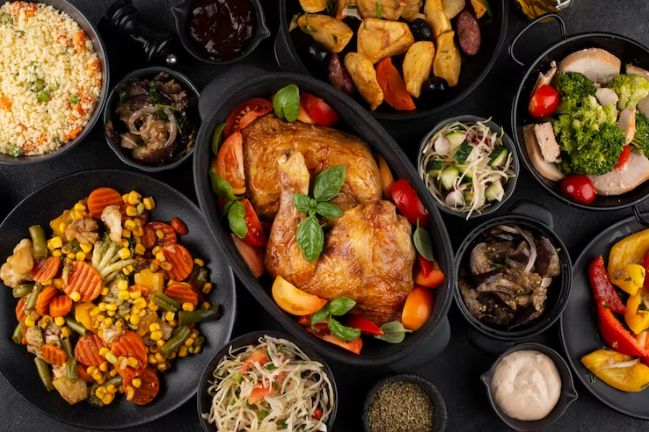Are you tired of going to restaurants and not being able to find anything on the menu that fits your dietary needs? You’re not alone.
With the rise of dietary preferences, restaurants are adapting their menus to cater to a wider range of customers. From vegetarian and vegan options to gluten-free and allergen-friendly dishes, the culinary world is becoming more inclusive than ever before.
Vegetarianism and veganism have seen a surge in popularity in recent years, and restaurants are taking notice. No longer are meat-free options limited to salads or a plain pasta dish. Many restaurants are now offering creative and delicious plant-based dishes that even meat-eaters can enjoy.
And it’s not just about accommodating those who choose to follow a vegetarian or vegan diet – many people are now reducing their meat intake for health or environmental reasons. Restaurants are recognizing this shift in consumer behavior and adapting their menus accordingly.

The Rise of Dietary Preferences in the Culinary World
You’ve probably noticed how dietary preferences have become a major factor in restaurant menus these days. With the rise of plant-based protein, flexitarianism, and sustainability, restaurants are now catering to a wider variety of diets and lifestyles.
This trend is not just about accommodating vegetarians or vegans, but also about providing options for those who want to reduce their meat consumption or choose more environmentally friendly options. Restaurants are now offering more plant-based protein options such as tofu, tempeh, and legumes, which are not only healthy but also sustainable.
Flexitarianism, or the practice of eating a primarily vegetarian diet with occasional meat consumption, is also gaining popularity. Many restaurants are now offering flexitarian-friendly menu items to cater to this growing trend.
With sustainability becoming a major concern for many consumers, restaurants are also incorporating more eco-friendly practices such as reducing food waste and using locally sourced ingredients.
Vegetarian and Vegan Options on Restaurant Menus
Many eateries now offer plant-based dishes to cater to those who avoid animal products. Vegetarian and vegan options are becoming more common on menus, and restaurants are getting creative with their use of plant-based protein and meat alternatives.
Dishes like veggie burgers, jackfruit tacos, and tempeh stir-fry are popping up on menus across the country. Plant-based protein is not only popular among vegetarians and vegans, but also among those who are looking to reduce their meat consumption for health or environmental reasons.
Many restaurants are now offering plant-based protein options as a way to cater to this growing trend. Meat alternatives like tofu, seitan, and veggie crumbles are being used in a variety of dishes, from salads to sandwiches to pasta dishes, providing a delicious and healthy alternative to traditional meat-based meals.
Gluten-Free and Allergen-Friendly Dishes
As more people become aware of their food sensitivities, it’s important for eateries to offer gluten-free and allergen-friendly dishes to accommodate a wider range of dietary needs.
Gluten-free dishes are becoming increasingly popular as more people are diagnosed with celiac disease or gluten intolerance. These dishes are made without wheat, barley, or rye, and can be substituted with alternative ingredients such as rice flour or almond flour. When offering gluten-free dishes, it’s important for restaurants to be mindful of cross contamination concerns, as even a small amount of gluten can cause a severe reaction in those with celiac disease.
Allergen-friendly dishes are also important for those with food allergies. These dishes are made without ingredients such as nuts, dairy, or shellfish, and ingredient substitutions are made to ensure that these dishes are safe to eat for those with allergies. When preparing allergen-friendly dishes, it’s important for restaurants to be aware of cross contamination concerns, as even a small trace of an allergen can cause a severe reaction in those with allergies.
By offering gluten-free and allergen-friendly dishes, restaurants can cater to a wider range of dietary needs and ensure that all customers are able to enjoy a safe and delicious meal.
The Paleo and Keto Diets: How Restaurants are Adapting
If you’re looking for a new way to eat healthier while dining out, consider trying the Paleo or Keto diets and see how restaurants are adapting to these popular eating styles. The Paleo diet focuses on whole, unprocessed foods while the Keto diet is a low-carb, high-fat diet.
Both diets have gained popularity in recent years, and restaurants are starting to offer more options to cater to these dietary preferences. Restaurants are now offering low carb options for those following the Paleo or Keto diets. This means you can enjoy meals that are high in protein and healthy fats while avoiding foods that are high in carbohydrates.
Additionally, restaurants are making ingredient substitutions to accommodate these diets. For example, cauliflower is often used as a substitute for rice or potatoes, and almond flour is used in place of regular flour for baked goods. With more and more people following these diets, restaurants are making it easier than ever to enjoy a healthy meal while dining out.
Meeting the Demand for Customizable Menus
You deserve to have control over what you eat, and now more than ever, restaurants are offering customizable options to meet your unique needs and tastes.
One way they’re doing this is through interactive menus that allow you to select and modify your dishes based on your dietary preferences. For example, you can choose to substitute a protein, remove an ingredient, or add an extra serving of vegetables. With an interactive menu, you have the freedom to build a meal that fits your lifestyle and health goals.
Some restaurants are also offering personalized recommendations based on your dietary preferences. This may involve working with a nutritionist or using data from previous orders to suggest dishes that align with your needs. For example, if you’re vegan, the restaurant may recommend a plant-based dish that’s high in protein and low in carbs.
By providing personalized recommendations, restaurants can make the dining experience more enjoyable and convenient for you. With customizable menus and personalized recommendations, you can feel confident that you’re making choices that support your health and well-being.
Do you want a more personalized dining experience? Read more
Frequently Asked Questions
What is the most popular dietary preference among restaurant-goers currently?
Are you wondering which dietary preference is most popular among restaurant-goers? Well, it seems that veganism is on the rise, but vegetarianism still reigns supreme. As for gluten-free substitutes, they can be hit or miss in terms of replicating the original dish.
Are there any unique dietary preferences that are emerging in the culinary world that restaurants are starting to cater to?
You’ll be pleased to know that plant-based innovations are taking the culinary world by storm. The future of sustainable cuisine is bright, with more and more restaurants catering to unique dietary preferences like those who prefer plant-based meals.
How do restaurants ensure that their menu items are truly gluten-free and allergen-friendly?
To ensure safety, restaurants have strict kitchen protocols in place to prevent cross-contamination and guarantee gluten-free and allergen-friendly menu items. Staff are trained to follow these guidelines and communicate with customers about their dietary needs.
What are some common challenges that restaurants face when trying to adapt to the paleo and keto diets?
Adapting to the paleo and keto diets can be challenging for restaurants. Customized menus and ingredient substitutions are necessary to meet these dietary preferences. Without proper knowledge and preparation, it can be difficult to cater to these customers.
Are there any notable examples of restaurants successfully catering to a wide range of dietary preferences with a single menu?
You’ll find multi-cuisine fusion restaurants that offer flexitarian options to cater to a wide range of dietary preferences. These establishments satisfy different needs without compromising on taste and quality.
Conclusion
So, there you have it. The restaurant industry is catering more and more to dietary preferences, with a focus on vegetarian and vegan options, gluten-free and allergen-friendly dishes, and even the popular Paleo and Keto diets.
As a diner, this means that you have more options than ever before, and can feel confident that there will be something on the menu that caters to your specific dietary needs.
But it’s not just about having options – restaurants are also adapting to meet the demand for customizable menus. This means that you can often tailor your meal to your specific dietary preferences, whether that means adding extra veggies to your dish or swapping out a side for a gluten-free option.
So, the next time you’re dining out, don’t be afraid to speak up and ask for what you need – chances are, the restaurant will be more than happy to accommodate you.



